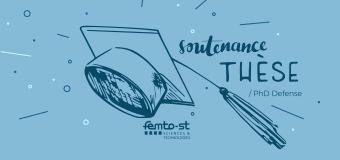You are here
- Home
- Hussein ZEAITER : "Modeling and Simulation of radio signals in confined environments using a software defined radio"

Hussein ZEAITER : "Modeling and Simulation of radio signals in confined environments using a software defined radio"
Tuesday 30 May - 1.30 P.MAbstract :
Tracking an end user or a connected object is a very important aspect in many fields such as transportation and navigation. The most known external navigation system is the Global Positioning System (GPS). The operation is based on the unidirectional transmission of a satellite signal located at an altitude of over 20,000 km. GPS provides accurate positioning results outdoors. However, GPS signal suffers from low availability in difficult environments, such as the indoor positioning area. Many IoT applications require tracking continuity in the indoor domain. To make this possible, it is necessary to build an indoor tracking system for emergency applications. Radio frequency engineering has attracted the attention of the research community in both scientific and industrial fields. Software Defined Radio (SDR) is a well known concept in the field of radio frequency tracking, bringing new possibilities, and allow us to study and investigate existing radio frequency technologies such as LoRa (Long-Range Low-Power). The objective of this thesis is to propose an indoor tracking solution that exploits the radio signals emitted from indoors in order to build a radio architecture composed of fixed elements (Anchor nodes) whose coordinates are known and mobile terminals whose coordinates are to determined.To achieve the objective, an approach was considered during this thesis: In a first step, a state of the art has been performed on the existing research works that study wireless technologies in the field of indoor tracking. These works present an overview of the most promising technological solutions and techniques for indoor tracking. In addition, this step involves a general study of Software Defined Radio technology, which consists of two parts, a software part that includes the GNU Radio and a hardware part that includes the USRP (Universal Software Radio Peripheral). The second step consists of designing and developing embedded software that organizes wireless radio communications between elements communicating with the LoRa wireless technology. The LoRa signals were processed and simulated using a SDR platform. Using the SDR allows for easy visualization and analysis of the LoRa signal profiles. Processing, demodulating, and decoding the LoRa signal were also part of my assignments. The demodulation and decoding process was performed using the gr-lora library integrated into GNU Radio, as well as a USRP-based SDR.In the third step, an AoA-based localisation system was proposed and implemented on a SDR platform. The proposed system measures the phase difference between the two antennas of an SDR in GNU Radio. The algorithm consists of detecting the presence of the LoRa signal in the channel, computing the phase of the signal for each antenna of the receiver, and measuring the AoA and the location coordinates of a moving transmitter using trigonometric functions. In addition, detecting and tracking a weak LoRa signal was implemented via dual antenna SDR. Due to its CSS (Chirp Spread Spectrum) modulation, LoRa can demodulate a signal down to -20 dB below the noise level. The objective of detecting signals below the noise level is as follows: First, it will increase the battery lifetime of the LoRa device. Secondly, it extends the communication distance between devices. Finally, it secures our communication and data exchange by preventing third party devices from gaining access our location coordinates.
Jury composition :
Denis GENON-CATALOT, Maître de conférences, Université Grenoble Alpes, Examinateur
Adriano MOREIRA, Associate Professor, Université de Minho, Rapporteur
Benoit HILT, Maître de conférences, Université de Haute Alsace, Rapporteur
Béatrice PAILLASSA, Professeur des universités, ENSEEIHT, Ecole nationale supérieure d'électrotechnique d'électronique d'informatique d'hydraulique et des télécoms, Examinateur
Oumaya BAALA, Maître de conférences, Université Bourgogne Franche-Comté, CoDirecteur de thèse
Thierry VAL, Professeur des universités, Université de Toulouse 2, Co-encadrant de thèse
François SPIES, Professeur, Université Bourgogne Franche-Comté, Directeur de thèse
Abdallah MAKHOUL, Professeur, Université Bourgogne Franche-Comté, Examinateur
Localization : UFC - Département DISC Département Réseaux et Télécoms Place Tharradin 25200 MONTBELIARD - salle Amphithéâtre RT2









